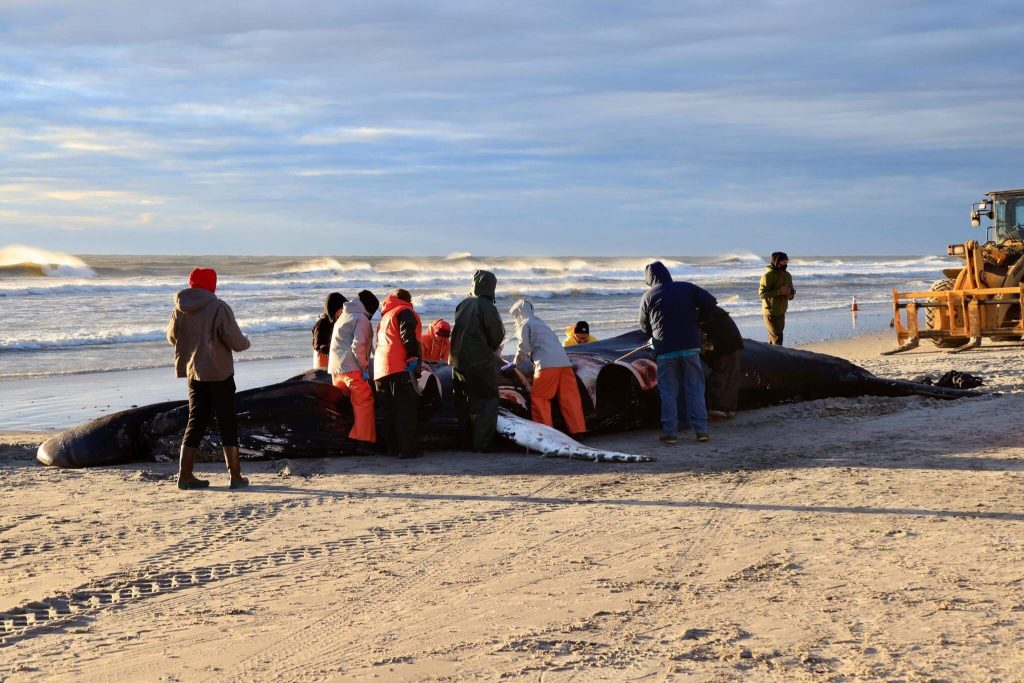Eleven whales have washed up on beaches in the mid-Atlantic region since the beginning of December 2022. The first was a humpback whale Dec. 2 in Southampton, New York. The most recent, as this is written, was also a humpback that washed ashore on Assateague Island, Virginia, Jan. 15.
In that span of six weeks, there were eight humpback whales, two sperm whales, and one right whale calf found dead on the beaches. Five of the whales came ashore in New Jersey, two each in New York and North Carolina and one each in Maryland and Virginia. If one is willing to look further south during the same period, an Orca died on a beach in Flagler County, Florida, Jan. 10.
The whales’ deaths have been at the center of an already heated debate over wind farm development off the Atlantic Coast, especially in New Jersey.
The National Oceanic and Atmospheric Administration (NOAA) and the Bureau of Ocean Energy management (BOEM) held a press conference in Atlantic City Jan. 18 to address the claims that the whale deaths were caused by preparatory survey work being done prior to construction of Ocean Wind 1, an 1,100-megawatt wind farm off the coast of Atlantic City.
The government officials said there was no evidence that offshore wind farm work played a role in the death of the whales.
Benjamin Laws, a NOAA official, put it in unambiguous terms: “There are no known connections with offshore wind activities and any whale strandings.”
Earlier in the week, Clean Ocean Action, a New Jersey coast environment advocacy organization, held their press conference also in Atlantic City, calling on residents and those concerned about the environmental impact of the wind farms to write President Joe Biden, demanding he halt offshore work while an investigation is conducted to determine the cause of the whale deaths.
Immediately following the NOAA press meeting, Clean Ocean Action posted a statement to social media venues reaffirming the organization’s call for an investigation and a halt to wind farm preconstruction activities.
Mayor Jay Gillian, of Ocean City, added his voice to those supporting a halt to offshore wind activities.
In his weekly update to residents, Gillian said, “I believe there should be a pause in offshore wind activity in the ocean until we are assured that this is not a contributing factor” to the whale deaths.
According to NOAA, whale deaths have been increasing for several years along the East Coast. Several of those whales studied show blunt force trauma most likely caused by being struck by large ships.
One theory scientists are offering is that warming ocean temperatures are causing the prey the whale feed on to shift their location northward, drawing the whales into heavily used shipping channels transporting freight to New York and New Jersey ports. This puts the whales at greater risk of being struck by the ships.
NOAA data says that 178 humpback whales have died and washed ashore since 2016. About half of those have had necropsies done. Forty percent of those studied show signs of ship strikes.
The simple fact is that whales are dying at an increasing rate along the Atlantic Coast. Some percentage of those deaths may be explained by altered feeding locations and heavily traveled shipping channels. Other factors, no doubt, play a role, as well.
Scientists and government officials are racing to find explanations. In some cases, the new sense of urgency is not because of the dead sea mammals, but rather the potential connection some groups are claiming to the offshore wind initiative that is central to the federal and state push into alternative energy sources.
Despite the evolving controversy over the whale deaths, the push into offshore wind continues. The Danish company, Ørsted, announced its intent to purchase Public Service Enterprise Group’s (PSEG) 25% stake in Ocean Wind 1 as soon as the acquisition can gain regulatory approval. This portion of the New Jersey offshore wind initiative is soon to be entirely in the hands of the Danish company.
Preparations for Ocean Wind 2, which is to be constructed just to the south of Ocean Wind 1, are also moving ahead. If projected schedules are met, the two massive wind farms will be supplying more than 2,200 megawatts of energy to New Jersey by 2029, a mere six years away.
Ørsted says that the actions its ships are taking as part of their preconstruction survey work do not include soundings at levels that could harm nearby whales.
The National Marine Fisheries Service has launched three separate investigations on the increase in whale deaths along the Atlantic Coast.
The only thing that seems certain right now is that the wind farm construction is pushing ahead. Full construction of Ocean Wind 1 is schedule to begin this year.
Thoughts? Questions? Contact the author, Vince Conti, at vconti@cmcherald.com.








